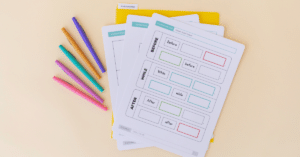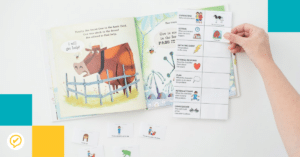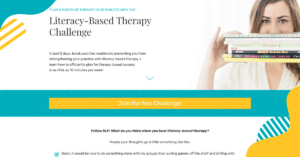So, there I am…walking into Johnny’s IEP meeting ready to celebrate all of the progress he’s made. He met all of his goals this year!
I make my way towards my usual seat when I overhear the general education teacher chatting with the resource room specialist…
“Johnny’s doing okay, but he just can’t seem to follow directions.”
“I agree. He needs so much support in the area.”
I quickly glance at Johnny’s IEP.
Johnny will follow two-step directions with 80% accuracy. Goal met.
And then I panic…
What am I going to say?
What do I do?
Will they think I’m a fraud?
I’m really not the anxious type. 😉
In all seriousness, I just wanted to run and hide at this point!
Have you ever been in my shoes?
This happened when I was a CF.
I was so embarrassed.
I never wanted to be in that situation again.
So, I took action…
After the meeting, I called my clinical supervisor to debrief. We talked about what happened and did some brainstorming.
My Mistakes
I knew I should have checked in with the teachers ahead of time. That was Mistake #1.
I did chat with the teachers prior to the IEP meeting, but I should have checked in with them on a regular basis. I also should have asked for input on Johnny’s specific goals. (It turns out she didn’t even realize Johnny was working on following directions, so I had some work to do there, too!)
But then we started talking about the bigger issue… Mistake #2.
What I was doing in therapy was not relevant.
We were playing really cute games and having fun. However, what happened in the speech room, stayed in the speech room… And that’s not what we want!
It didn’t matter if Johnny could follow 38-step directions in my room. He needed to be able to follow directions in the classroom!
And Johnny wasn’t the exception…
I wasn’t doing enough to help my students connect the skills we were targeting in therapy to the “real world.”
And let’s be real… I was totally and completely overwhelmed.
How in the world was I supposed to help my 60+ students generalize what they were learning?
What I Found
I did some research and kept reading this phrase: Contextualized Language Intervention.
I started implementing some of the ideas and strategies that I found in the research, and I was hooked.
My students were just as engaged (if not more!), and we were making real progress.
I saw it. The student saw it. The teachers saw it.
It was amazing!
Contextualized Intervention?
Okay… Let’s back up a second.
What is contextualized intervention? It is when we “provide explicit skill instruction in ways that are meaningful and purposeful to the student” (Ukrainetz, 2007).
We can make sure that what we are doing is meaningful and purposeful by communicating with those around us! I started communicating with teachers to find out what students are working on in the classroom.
The context is clearly very different depending on the age of the student!
Preschool is filled with games, music, and crafts. Early elementary students are reading picture books and doing science projects. Secondary students are diving into textbooks and writing papers.
The context can also vary by classroom and by teacher, which is why it’s so important to communicate.
Being relevant is key!
We need to consider our students’ context when writing goals and developing treatment plans.
Don’t Just Take My Word for It
Here’s what others have to say about this approach…
“I have been advocating that SLPs engage in ‘curriculum-relevant therapy’… that they use curriculum as context for language therapy but not try to teach curriculum per se. In this approach, an SLP would focus on language processes, or ‘underpinnings'” (Ehren, 2009).
“Gillam, Gillam, and Reece (2012) provided small-group intervention three times a week over 6 weeks. The intent of the research study was to evaluate narrative intervention that is contextualized (literacy based) versus decontextualized commercially available games and drill cards designed to increase vocabulary, sentence complexity, and social language. The contextualized intervention used explicit and implicit questions, vocabulary, and syntax thematically tied to literature. The results indicated that students’ comprehension and story retelling/generation skills improved more with the contextualized intervention as compared to decontextualized intervention” (Brandel, 2014).
ASHA has something to say about it, too…
“Individualized programs always relate to the school work. Therefore, materials for treatment are taken from or are directly related to content from classes.” (ASHA Guidelines)
But…
Yeah, I know.
There’s a big “but” there.
This sounds amazing, but how do I find the time to implement this with my caseload of 100 students?
It sounds like a lot of work.
It definitely was not an overnight win for me, but it is totally do-able. We can do this together!
If you’re on board, stay tuned! I’m going to be sharing tips, tricks, and resources to help you make this happen.






Leave a Reply